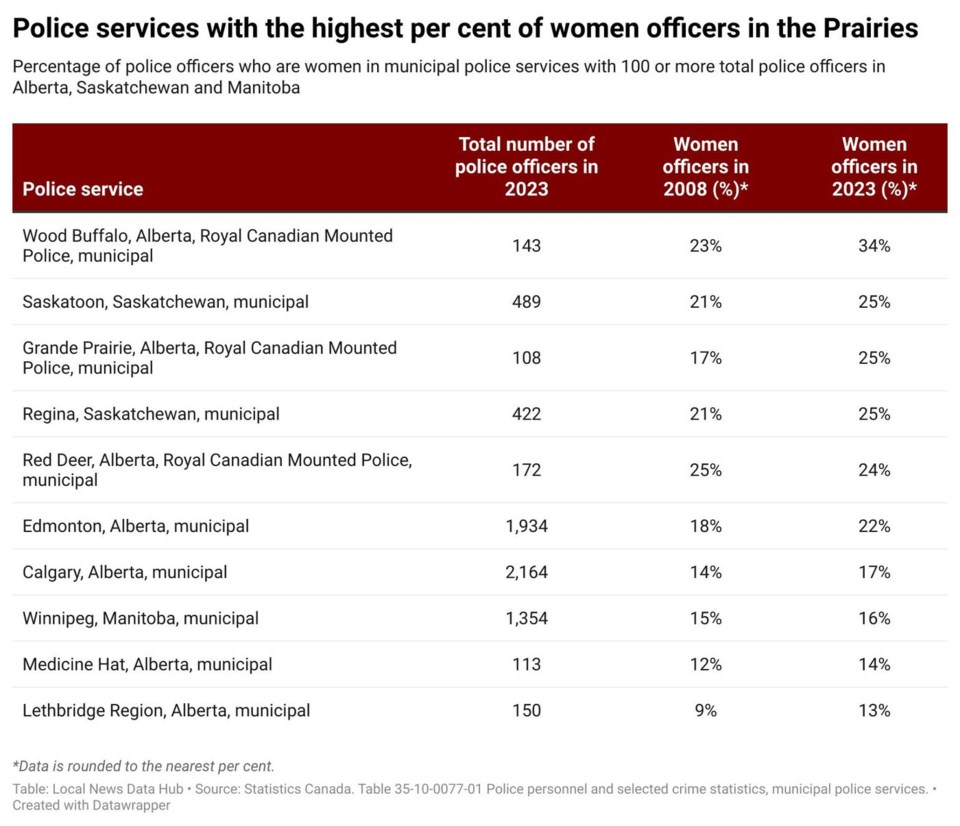LOCAL NEWS DATA HUB ŌĆö Women police officers remain significantly underrepresented in the largest police services across the Prairie provinces despite evidence suggesting they are often preferred by victims of domestic violence or sexual assault, are less likely to use force, and may be better at de-escalating tense situations.
Among the 10 local police services in Manitoba, Saskatchewan and Alberta with at least 100 officers in 2023, gender diversity was greatest in the Wood Buffalo RCMP detachment serving Fort McMurray and its environs, according to a new analysis by the Local News Data Hub at Toronto Metropolitan University. Women made up 34 per cent of the 143 uniformed frontline and senior officers who comprise the detachmentŌĆÖs sworn ranks.
The next best performers were the municipal police department in Saskatoon and the RCMP-run detachment serving Grande Prairie, Alta. In both cases, 25 per cent of sworn officers were women.
The 30x30 Initiative, a coalition of Canadian and American police agencies and researchers supporting the advancement of women in policing, suggests a group must make up at least 30 per cent of an organization before it can influence its culture.
After identifying the 75 local police departments in Canada with 100 or more sworn officers in 2023, the Data Hub ranked them based on the percentage of women in each service. Across the country, only nine met or surpassed the 30 per cent threshold for gender representation.
The underwhelming results of efforts to recruit and retain women in the field come at a time when many argue they are essential to effective policing.
ŌĆ£It helps build the trust and confidence in the community when they see more women in the police force,ŌĆØ said Inspector Kimberly Mueller, the officer in charge of Indigenous policing services and recruiting for the Alberta RCMP.
Mueller, a member of the Mikisew Cree in northeastern Alberta, said victims of sexual assault and children who are part of investigations often feel safer and more supported if a woman officer is involved.
Women officers, she added, also resort to force less often. ŌĆ£I can count on one hand how many hands-on situations I've had ŌĆō 99.9 per cent of the time I could usually say to the person ŌĆśLook, we can fight today, but I don't want to,ŌĆÖŌĆØ she said. ŌĆ£I don't know if many men would take that approach.ŌĆØ
A study by Carleton University researchers that examined the use of force at one large Canadian police service concluded that its women officers were about half as likely as their male counterparts to ever employ force.
The Data Hub based its ranking on personnel data submitted annually by municipal police services to Statistics CanadaŌĆÖs Police Administration Survey. Brianna Jaffray, from the Canadian Center for Justice and Community Safety Statistics at Statistics Canada, confirmed that comparing the surveyŌĆÖs personnel data across jurisdictions and over time was a valid approach. The data also showed that:
- Overall, 23 per cent of sworn officers across Canada were women in 2023, up from four per cent in 1986 when Statistics Canada began collecting data.
- MontrealŌĆÖs police service had the highest proportion of women officers in its sworn ranks ŌĆō they accounted for 35 per cent of its 4,507 officers in 2023. The municipal service in Longueuil, Que. was second (34 per cent) while the Wood Buffalo RCMP detachment ranked third.
- Women officers were notably underrepresented in the municipal police service in Lethbridge, Alta. which placed 73rd out of 75. While the number of women in the serviceŌĆÖs sworn ranks increased to 19 in 2023 from 14 in 2008, they still only made up 13 per cent of the departmentŌĆÖs 150 officers. The Medicine Hat Police Service in southeast Alberta, where women constitute 14 per cent of 113 officers, ranked 70th out of 75.
- Women are also notably underrepresented in major police departments across the Prairies. They made up 16 per cent of the 1,354 sworn officers in the Winnipeg Police Service, 17 per cent of the 2,164 officers in the Calgary Police Service and 22 per cent of the 1,934 officers in the Edmonton Police Service.
The Brandon Police Service in Manitoba and Regina Police Service in Saskatchewan are among just eight Canadian members of the 30x30 Initiative, which says the ŌĆ£under-representation of women in policing undermines public safety.ŌĆØ While the City of Edmonton has committed to the goal, a spokesperson for the Edmonton Police Service said the service itself has not. Signatories commit to increasing womenŌĆÖs representation among police recruits to 30 per cent by 2030.
Carrie Sanders, a Wilfrid Laurier University criminology professor and co-author of a study that examined how women navigate the ŌĆ£boysŌĆÖ clubŌĆØ mentality in policing, said in an interview that integrating women isnŌĆÖt just about boosting numbers. ŌĆ£It's about creating a cultural space of inclusion that allows the women to do well and flourish.ŌĆØ
The research team interviewed 91 women, most of them sworn officers, and Sanders said participants frequently mentioned having to deal with ŌĆ£sexual innuendos being made on the job, or statements that no one should be expected to have to listen to or learn to laugh off, in order to feel like they're just part of the club.ŌĆØ
The study, published in a 2022 issue of Feminist Criminology, includes one officerŌĆÖs description of being left alone to de-escalate a situation. Her backup said he wanted ŌĆ£to make sure you can handle yourself, be one of us.ŌĆØ Another interview subject observed that ŌĆ£youŌĆÖre a member of the brotherhood unless you challenge the men.ŌĆØ Researchers also heard that being accepted into the boyŌĆÖs club meant ŌĆ£not be(ing) as friendly to the other women.ŌĆØ
Recent history suggests changing police culture remains a work in progress for many services. In 2019, for instance, a Wood Buffalo RCMP officer pleaded guilty to common assault after inappropriately touching a female co-worker without consent.
A 2020 report that reviewed the treatment of women in the RCMP, which is contracted to provide local policing in more than 150 Canadian communities, concluded its culture was ŌĆ£toxicŌĆØ and ŌĆ£tolerates misogyny and homophobia at all ranks and in all provinces and territories.ŌĆØ The report was part of a $125.4-million class action settlement with more than 2,300 women RCMP officers and civilian employees who experienced workplace gender and sexual orientation harassment and discrimination between 1974 and 2017.
Mueller suggested the RCMP work culture has improved because there are more women to support each other. New systems, she insisted, are also ŌĆ£keeping 99 per cent of people on the straight and narrow and creating a more respectful workplace. Unfortunately, you're always going to get those one percenters.ŌĆØ
These days, she said, there are opportunities for advancement with the RCMP in smaller communities, but not everyone is willing to move to more remote locations. ŌĆ£Not a lot of people go ŌĆśyeah, I'll put up my hand. I'll go to Fort McMurray,ŌĆÖŌĆØ she added. ŌĆ£They want to be near Edmonton and Calgary ŌĆō a little more central.ŌĆØ
The downside of working in a smaller detachment, Mueller added, is that officers may be alone on call and ŌĆ£a lot of women just don't see themselves respondingŌĆ”by themselves in the middle of the night.ŌĆØ
Chody Sutherland, the superintendent of support services for the Winnipeg Police Service, said policing traditionally has been a male career and that ŌĆ£doesn't change overnight.ŌĆØ
Women recruits, she said, are put off by extensive media coverage of police, the overtime hours and the potential dangers. ŌĆ£Certainly there are other jobs that are dangerous, but you're not seeing them highlighted in the news the way policing is,ŌĆØ she said. ŌĆ£So it's not necessarily something people want to bang down your door to do.ŌĆØ
Sutherland said while recruiting women officers is important, the Winnipeg Police Service ŌĆö which ranked 69th out of 75 for gender diversity ŌĆö also has other diversity considerations: ŌĆ£We're always looking to make sure we have a significant Indigenous component and a racialized component,ŌĆØ she said.
The top-ranked Montreal police service, which boosted the number of women in its sworn ranks to 35 per cent in 2023 from just under 30 per cent in 2008, aims to attract recruits by highlighting successful women role models, Rose-Andr├®e Hubbard said in a written statement translated from French.
Hubbard, the Montreal serviceŌĆÖs equity, diversity and inclusion advisor, said the department visits schools to promote policing careers for women and hosts recruitment events where the benefits and challenges of being a woman officer are openly discussed.
Other best practices identified by researchers include recruiting from more than just criminal justice-focused college and university programs, highlighting educational and professional development opportunities, and putting in place on-site childcare and other family-friendly policies such as job sharing, part-time work and more flexible shift work.___
This story was produced by the Local News Data Hub, a project of the Local News Research Project at Toronto Metropolitan UniversityŌĆÖs School of Journalism, with support from the Investigative Journalism Foundation. The Canadian Press is the Data HubŌĆÖs operational partner. Detailed information on the data and methodology can be found here: https://localnewsdatahub.ca/stories/
Apurva Bhat and Carly Penrose, The Canadian Press



